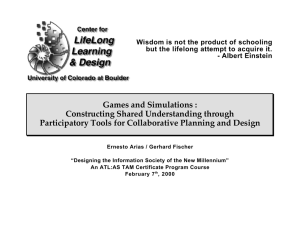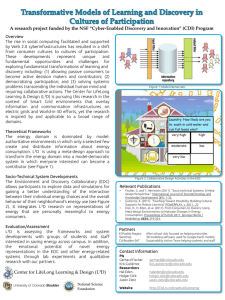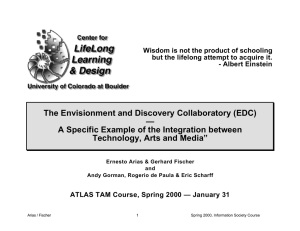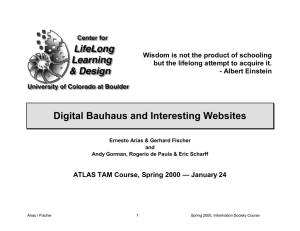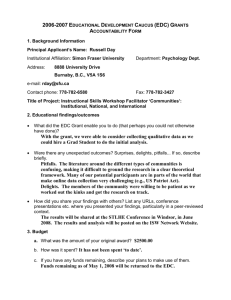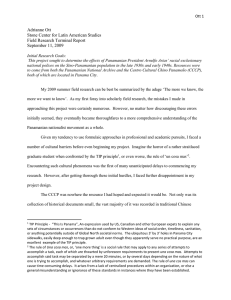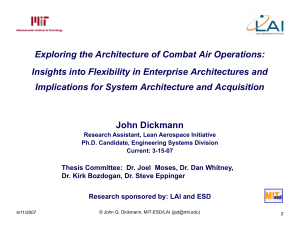Creating Environments to Support Collaboration in Learning, Design & Planning:
advertisement
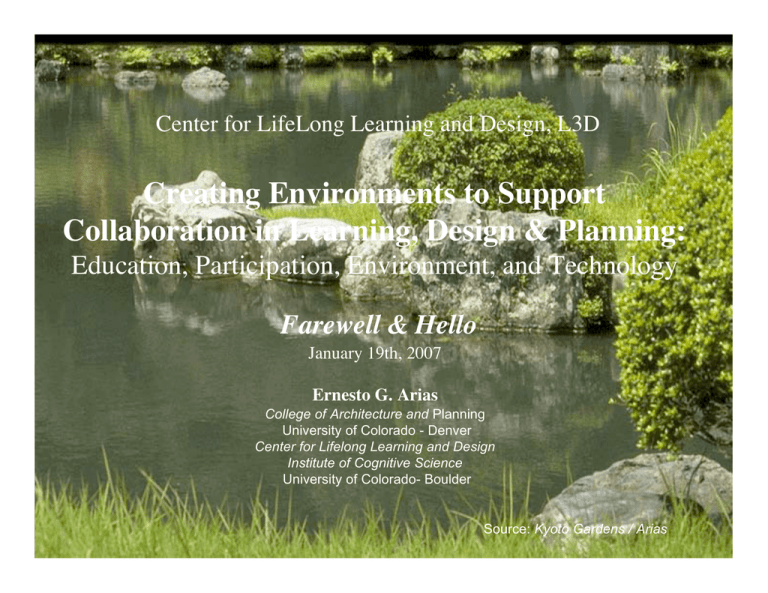
Center for LifeLong Learning and Design, L3D Creating Environments to Support Collaboration in Learning, Design & Planning: Education, Participation, Environment, and Technology Farewell & Hello January 19th, 2007 Ernesto G. Arias College of Architecture and Planning University of Colorado - Denver Center for Lifelong Learning and Design Institute of Cognitive Science University of Colorado- Boulder Source: Kyoto Gardens / Arias An Overview Apreciation Concerns, Interests and Basis behind work practice, participation, tools, environment Programs … selected efforts to address concerns UG in Planning, L3D, ProDUS and RIF-GAE Closing thoughts … the Next Phase Extending CU Programs in to CR/LA efforts Appreciation At PENN Wm. G. Grigsby, Jon T. Lang, Seymour Mandelbaum, Ian McHarg, Britt Harriss, Dave Wallace, Ed Bacon, and Kevin Lynch At CU • CS and ICS • L3D members: past and present • CAP: facultyand a group of Ph.D., Masters and UG students • Others at CU in various departments and programs • Folks in Administration (Boulder & Denver)… Bruce Ekstrand a colleague and friend Beyond CU • Bob Harris at NCAR, Hanns Seidler at TUD, Frieder Nake at UBremen and Luc Anselin at UI, Joni Teeter at EPA, Will Toor at Boulder County • UCR & CENAT: Rosendo Pujol, Carlos Quesada, Gabriel Macaya and Yamileth Garcia, Pedro Leon and Jorge Gutierrez, and Guy DeTeramond • COLAM: The Executive Council, Patricia Gudiño and Arcadio Cerda at U of TALCA, Chile My family Background Basis Concerns, and Interests Architectural Thesis - U of Fla, A Rehabilitation & Training Facility 1968 Creating a New City Planning & Design Practice (w/McHarg & Wallace) [1977-1980] Region City Abuja, Nigeria - 1978-1981 City Core Abuja’s Center: from design to reality Planning & Design Practice Recycling the City: Miami Park West’s Redevelopment Program (w/McHarg & Wallace) Complex systems : creativity focus structure and function Roles of Client and the Critical Coalition Designing framework: Design Criticsa –design Prescriptive & Performance Creating avisualization space for creative solutions Information Making tacit knowledge explicit Backtracking arguments Nature of Design Problems Some problems are of the type … X+2=6, what is X=? Their nature has the following characteristics… ¬ Well structured with known definitions and can be solved; ¬ Solutions are of a “right/wrong” type; ¬ Have an ending point These are TAME problems Other problems are of the type … Mom: “Mary, do me a favor, go to the grocery store. We need milk, bread and cheese. All I have is $5, so decide what to get and bring me the change.” Mom: “Mary, do me a favor, go to the grocery store with your brother. We need milk, bread and cheese. Between the two of you decide what is most important to get with the $5 and bring me the change.” The nature of these problems have the following characteristics … ¬ ¬ ¬ ¬ ¬ “Open-ended,” “ill-defined” and do not have “right/wrong”type solutions “Multiple objectives and multiple criteria” for their framing and resolutions Characterized by conflict and change therefore do not have solutions… only resolutions Multiple participants/stakeholders who change, and enter or leave the “problem space” Uniqueness These are WICKED problems (Rittel,Webber, Simon)… design problems An Argument Behind Participation: Its Importance in Design and Planning • Planning/Design => E <= => B => notion of ”fit” • “fit” => “is” vs. “should be” => the notion of “problem” • Nature of these Problems … “wicked” (Rittel,Webber, Simon) And… • Individuals/groups are the owners of problems… have the relevant tacit knowledge Therefore… • Informed participation in Planning/Design is valuable … --> tacit knowledge explicit --> informed compromises --> construction of shared understanding --> framing and resolution of problems • lead to interventions … or design and planning solutions Or… sometimes more problems? Complementing the Symmetry of Ignorance in Participatory Planning… The Asymmetry of Knowledge [Arias, 1997] While individual knowledge should be considered of equal importance … It is asymmetrical in terms of its relevancy Its RELEVANCY is contingent on the “participation situation” and: Participants • It emerges from the situational context T = Problem 1 2 3 • It is dynamic and its focus changes • It is NOT equally relevant all the time Organization Asymmetry of Knowledge in a Participatory Planning Situation Tools SIMLab at CAP & L3D Designing to Learn and Learning to Design Tools of the SIMLab at CAP : Designing to Learn and Learning to Design Training Neighbors The Cole Neighborhood, Denver, CO. Helping Neighbors Help Themselves (Arias 1990) Block Level Simulation INTERSim & EDC 3d simulation objects transparent interactive panel interactive panel controller simulation server mirror Idea - 1993 video projector InterSim 1994 EDC 1996 EDC / PitA - Action Space Population growth, carrying capacity of natural resources and human behavior … “The tragedy of the commons” Harding Environment Beyond the Proverb … from “Do not give them fish, teach then how to fish” Only One to “Do not teach them how to fish, teach them how to manage our rivers and oceans” The larger purpose behind planning --How can it be supported to address such concerns? 1988 Higher Education The world we have created is a product of our thinking. It cannot be changed without changing out thinking A. Einstein 1998 Programs …Efforts to address concerns and integrate experience 2004 Regional & Urban Sustainability: Supporting National Agencies and Municipal Governments Costa Rica, CA 1990 With Rosendo Pujol, Ph.D. Carlos Quesada, Ph.D. Universidad de Costa Rica Ecology and Natural Systems An Undergraduate Planning Program 1988 Sustainable Environments (2006) Healthy Commnity Development (2006) Designed and Planned Systems Social and Physical Next Phase … Extending CU programs through integrations with existing efforts in CR The future of our created world is not out there to be discovered (as in the natural sciences) … it needs to be designed by us Banco Nacional de CR, Museo del Oro, 2005 CRUSA Project - 2006-08 Univeristy of Costa Rica, Ministry of Education and L3D Introducing Environmental Awareness in the Public High School Curriculum Utilizing New Information Technologies EDC/PitA transfer High Schools in the GAM Extending Programs CS and L3D College of Architecture and Planning CS Dept. CRUSA Project Graduate Planning UCAR/NSF DLESE CYE Places ICS CRUSA Project ICS Ph.D. We will miss this! Arias 2006 But … We will enjoy this! Arias 2006 Playing Architect Again - Property Views of the Central Valley So … Farewell and Thanks And Hello and welcome!
